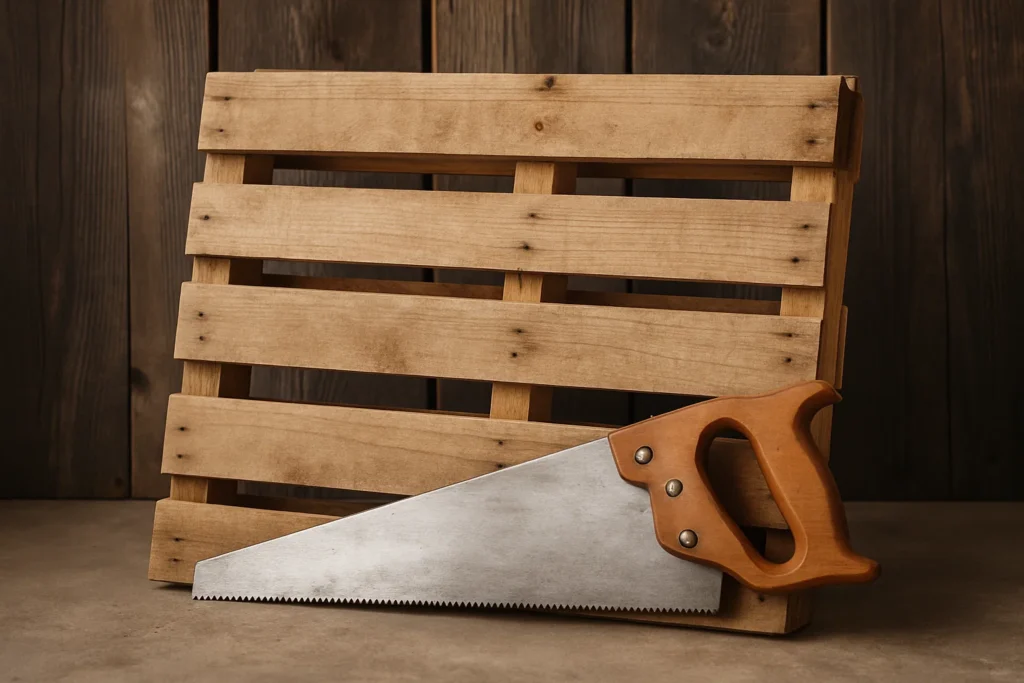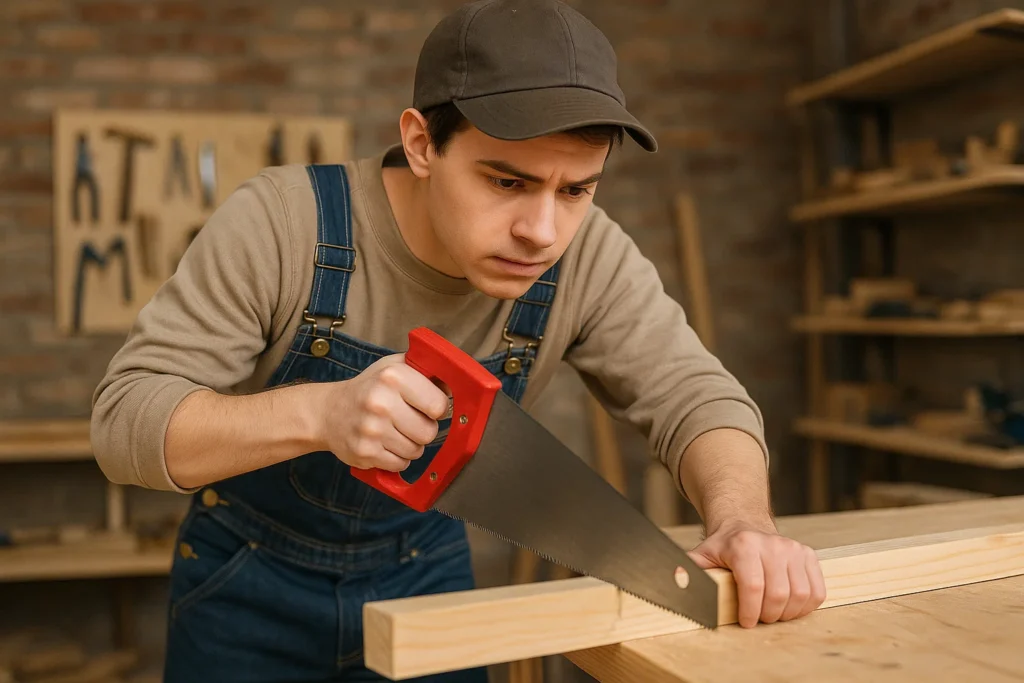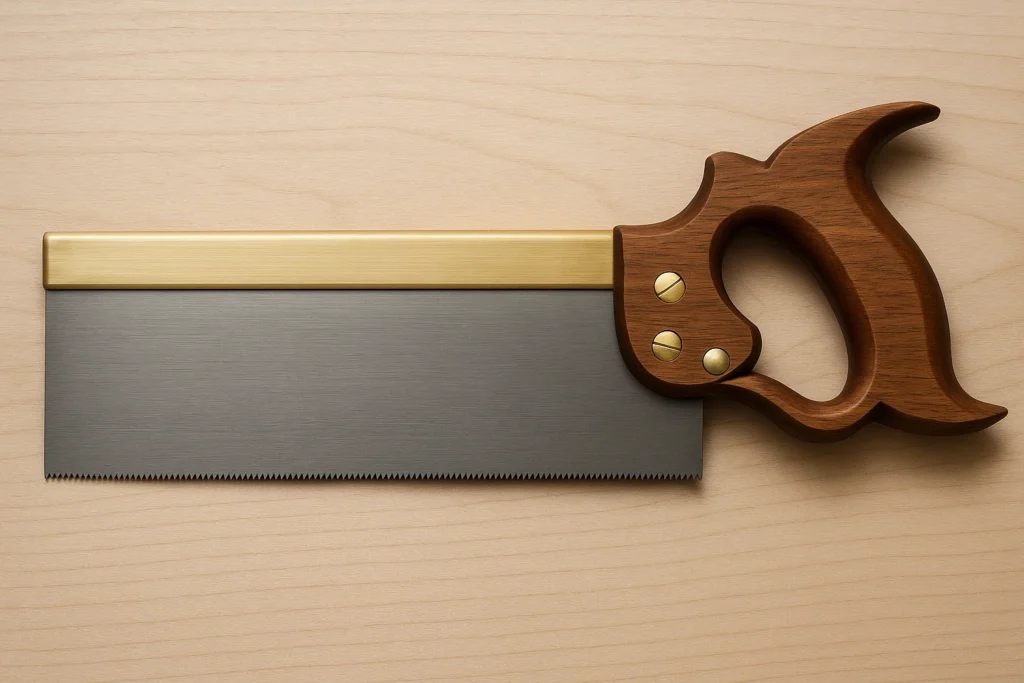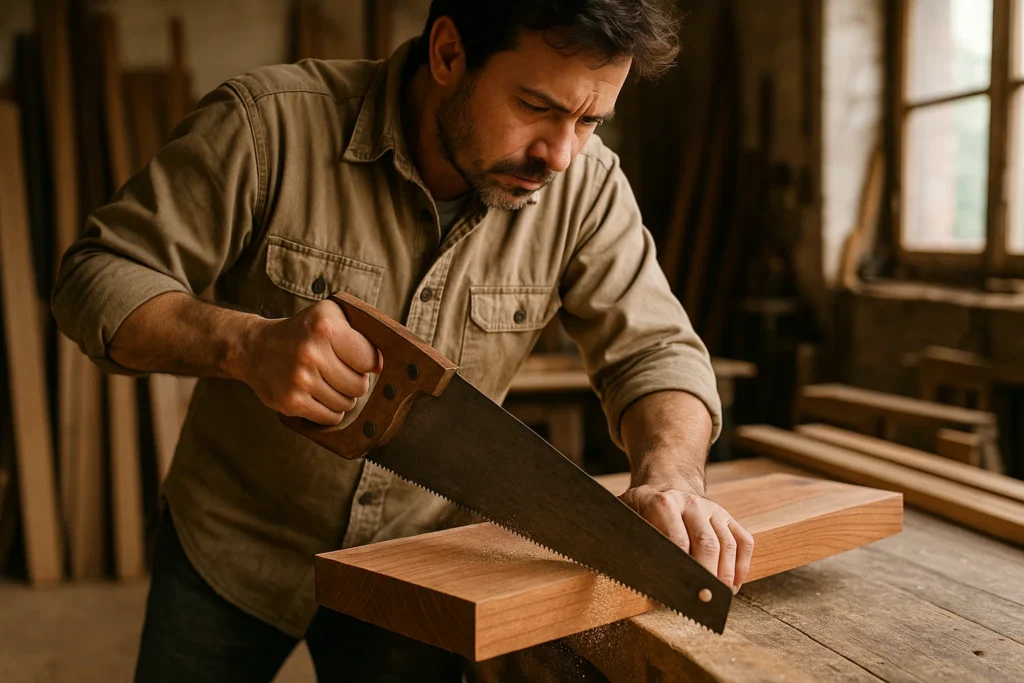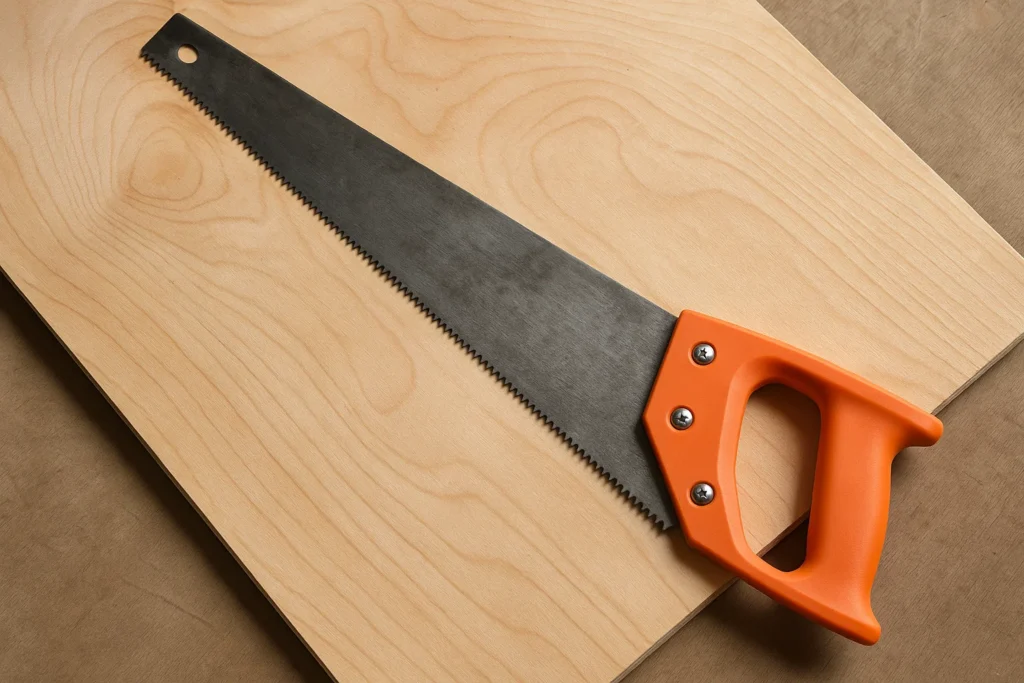Bahco’s 244P‑20‑U7‑HP Barracuda is a rugged 500 mm high‑speed‑steel handsaw with 7 tpi toothing and a comfy two‑component handle, delivering stable, razor‑sharp cuts and lasting edge retention for heavy‑duty pallet work.
One Wrong Move & Blade Is Ruined
Cutting pallets may seem simple, but it comes with real challenges. Pallets are often made from mixed wood types, packed with hidden nails, and built to be tough.
The wrong saw can slow you down, wear out quickly, or even become unsafe.
Whether you’re breaking down pallets for firewood, DIY projects, or reclaimed wood, choosing the right hand saw makes all the difference.
Here’s what to know—and the best options to get the job done right.
Important Takeaways
- Cutting pallets is tough due to mixed woods, hidden nails, and tight boards.
- Use saws with 7–11 TPI for best results—fewer teeth cut faster, more teeth cut cleaner.
- Blade length matters: 15–22 inches is ideal based on space and task.
- A strong, stiff blade helps avoid bending in tight pallet gaps.
- Handles should be ergonomic and non-slip to reduce fatigue.
- Choose nail-tolerant or replaceable blades to handle hidden fasteners.
- Bahco Barracuda is best overall—durable, sharp, and accurate.
- Use long, low-TPI saws to break down full pallets quickly.
- Use short, stiff saws to cut slats still attached to frames.
- Use replaceable or nail-tolerant blades when cutting through nails.
- Use medium TPI blades for cleaner cuts in furniture-ready pallet wood.
- Always wear gloves and safety glasses to avoid injury.
- Check for nails before cutting to prevent blade damage.
- Steady the pallet to avoid slipping while sawing.
- Let the saw do the work—don’t force it through tough spots.
- Pick a saw based on your task—speed, finish, or portability.
Some Images are generated by AI for illustration.
Best Hand Saws For Cutting Pallets
Hand Saw | Details | Blade Length | TPI |
|---|---|---|---|
19.7″ (500 mm) | 7 TPI | ||
19.7″ (500 mm) | 7 TPI | ||
20″ (508 mm) | 8 TPI | ||
15″ (381 mm) | 8 TPI | ||
12″ (305 mm) | 14 TPI |
Note: We don’t test products ourselves. Instead, we go through user reviews and/or community discussions to find and recommend the best options.
1. Bahco Barracuda
Bahco’s 244P‑20‑U7‑HP Barracuda is a rugged 500 mm high‑speed‑steel handsaw with 7 tpi toothing and a comfy two‑component handle, delivering stable, razor‑sharp cuts and lasting edge retention for heavy‑duty pallet work.
Key Features
- Blade Length: 19.7″ (500 mm) for long, uninterrupted cuts through pallet boards.
- TPI: 7 TPI for fast, aggressive cutting of rough lumber.
- Blade Material: High speed steel for lasting sharpness and wear resistance.
- Handle Type and Material: Screwed two-component handle for secure grip and built‑in marking guides. Handle with a perfect rubberized grip and good sawing support.
- Saw Type: General purpose hard point saw for versatile cutting of softwood, worktops, chipboard and MDF.
- Cutting Angle / Set: 45° and 90° marking guides for accurate angle cuts
- Weight: 0.95 lb (0.43 kg) for easy, fatigue‑free use.
Pros & Cons
Pros:
- Long-Lasting Sharpness: Maintains a razor-sharp edge for months of heavy use, cutting down on frequent tool changes.
- Robust Construction: Thick, high-speed-steel blade resists flex and holds up under jobsite abuse for reliable performance.
- Effortless Green-Wood Cutting: Super-sharp toothing slices through fresh timber and pallets with minimal user fatigue.
- Comfort & Control: Two-component screwed handle offers a secure grip and built-in 45°/90° marking guides for precise layout.
- Stable, Rattle-Free Cuts: Blade thickness prevents vibration and wandering, ensuring straight, accurate sawing every time.
- Best-in-Class Reputation: Hallmarked by professionals as a top-tier saw worth its slight premium.
Cons:
- Premium Price Point: Higher cost than entry-level rip saws.
- Not a Dedicated Rip Saw: Tooth geometry favors general-purpose cutting over ultra-fast ripping.
- Occasional Fulfillment Errors: Reports of receiving incorrect third-party brands when ordered online.
Note: These pros and cons are based on user review trends and latent consensus.
Our Verdict
A no‑nonsense, professional‑grade saw that excels at pallet work.
Buy If:
- You need a blade that holds its edge through months of pallet cutting.
- You want a sturdy, vibration‑free blade for straighter cuts in rough timber.
- Built‑in 45°/90° marking guides will speed up your setup.
- You frequently tackle green or reclaimed pallet wood with minimal effort.
Don’t Buy If:
- You’re strictly after the cheapest rip saw available.
- Ultra‑fast ripping of long boards is your top priority (tooth geometry is general‑purpose).
In practice, the Bahco 244P‑20‑U7‑HP is a worthwhile investment for serious pallet‑cutters seeking durability, comfort, and accuracy—just expect to pay a bit more for its top‑tier performance.
2. Stanley Fatmax
The Stanley Fatmax Gen2 hand saw offers fast, straight cuts in pallet wood with its stiff high‑speed steel blade and replaceable design. It’s built for tough DIY and pro use but needs care around hidden nails and in wet environments.
Key Features
- Blade Length: 19.7″ (500 mm) for cutting across full pallet boards
- TPI: 8 PPI (7 TPI)
- Blade Material: High‑Speed Steel for long‑lasting sharpness
- Handle Type and Material: Closed grip handle, TPR
- Saw Type: Manual hand saw for portable, tool‑free cutting
- Cutting Angle / Set: [Not provided]
- Weight: 1.48 lbs (0.67 kg) for reduced user fatigue
Pros & Cons
Pros:
- Fast cutting: Aggressive teeth and stiff blade deliver rapid cuts through pallet boards.
- Durable sharpness: High‑speed steel blade stays sharp after repeated use.
- Precise control: Hefty weight and rigid design enable straight, clean cuts.
- Comfortable grip: Ergonomic handle fits the hand for better tracking and less slip.
- Replaceable blade: Swap blades to extend tool life and maintain cutting performance.
- Versatile use: Handles fresh and seasoned wood with consistent performance.
- Anti‑corrosion potential: Solid build suits occasional seaside or humid‑air use.
Cons:
- Vulnerable to metal: Blade teeth can chip or break if nicked by hidden nails.
- Handle material: Plastic handle may wear faster than metal or rubber alternatives.
- Not ideal for small branches: Large 19.7″ (500 mm) blade is unwieldy on thin 2″ (50 mm) green limbs.
- Corrosion risk: Blade may need extra coating or oiling in salty environments.
Note: These pros and cons are based on user review trends and latent consensus.
Our Verdict
Short and powerful saw tailored for heavy pallet work.
Buy If:
- You need fast, aggressive cuts through thick pallet boards
- You want a stiff blade that resists bending under pressure
- You value replaceable blades for long‑term use
- You seek straight, clean cuts without wobble
- You use both fresh and seasoned wood interchangeably
Don’t Buy If:
- You often encounter hidden nails that could chip teeth
- You need a lightweight saw for very small branches
- You prefer a metal or rubber handle over plastic
- You work in salty or highly humid environments without extra rust protection
The Stanley Fatmax Gen2 delivers speed, strength, and precision for pallet cutting. It excels at heavy DIY and pro‑job tasks but needs care around metal and in corrosive settings.
Its replaceable blade design and solid build make it a top pick for anyone focused on efficient, straight cuts in pallet wood.
3. IRWIN ProTouch
The IRWIN ProTouch 20″ coarse‑cut handsaw delivers fast, rough cuts through pallet wood with a comfortable hardwood handle and deep gullets for smooth chip removal. It’s budget‑friendly and built for heavy‑duty use.
Key Features
- Blade Length: 20 in (50.8 cm)
- TPI: 9 pt/in (8 TPI)
- Blade Material: High‑speed steel
- Handle Type and Material: Ergonomic ProTouch hardwood handle
- Saw Type: Coarse‑cut handsaw
- Cutting Angle / Set: [Not provided]
- Weight: 1 lb (0.45 kg)
Pros & Cons
Pros:
- Affordable Value: Low price delivers strong cutting performance without high investment.
- Sharp Out of the Box: Ready‑to‑use edge handles dense pallet boards with minimal setup.
- Fast Chip Clearance: Deep gullets eject sawdust quickly, keeping the blade moving through slats.
- Comfortable Grip: ProTouch hardwood handle reduces hand fatigue during extended cutting.
- Durable Blade: High‑speed steel edge stays sharp through hundreds of cuts in rough lumber.
- Versatile Cutting: Coarse‑cut design tackles both cross‑cuts and rough rip‑downs of pallet planks.
Cons:
- Rough Finish: Coarse teeth leave noticeable saw marks, requiring a plane or sandpaper for smooth pallets.
- Hard to Start on Curves: Initial bite can stall on rounded or warped pallet boards.
- Bulky Profile: 20‑inch length is less packable than a compact backpack saw for field work.
- Potential Binding: Blade may bind in very dense or pitchy woods without lubrication.
- Not for Fine Cuts: Lacks the finesse needed for precision joinery or trim‑quality edges.
Note: These pros and cons are based on user review trends and latent consensus.
Our Verdict
Looking for a reliable saw to rough‑cut pallets? Here’s the bottom line.
Buy If:
- You want strong cutting power on a budget
- You need quick chip removal for fast work
- You’ll make rough cuts that don’t need a smooth finish
- You plan long cuts and need a comfy handle
Don’t Buy If:
- You need fine, trim‑quality edges
- You want a compact saw for hiking or tight spaces
- You work often on curved or warped boards
- You dislike occasional binding in dense wood
This IRWIN ProTouch saw is a workhorse for breaking down pallet lumber fast and affordably. It won’t give you smooth, joinery‑grade cuts, but it excels at rough cross‑cuts and rip‑downs with minimal effort.
4. Stanley SharpTooth
A 15‑inch hand saw with a 9 TPI SharpTooth blade that makes quick, rough cuts on pallet boards. It’s lightweight, budget‑friendly, and built for easy, replace‑rather‑than‑sharpen use.
Key Features
- Blade Length: 15 in (381 mm) fits most toolboxes
- TPI: 9 points per inch (8 TPI) for fast, efficient cuts
- Blade Material: High speed steel for precision-ground, razor‑sharp teeth
- Handle Type and Material: Molded handle for firm, comfortable grip (material unspecified)
- Saw Type: SharpTooth manual hand saw delivers fast cuts on push and pull strokes
- Cutting Angle / Set: Back of saw marked at 45° and 90° for quick angle marking
- Weight: 5.76 oz (163g)
Pros & Cons
Pros:
- Excellent value: Budget-friendly price without sacrificing cutting performance.
- Fast, efficient cuts: SharpTooth blade powers through pallet boards and branches with ease.
- Long‑lasting edge: Precision‑ground teeth hold their sharpness over multiple projects.
- Lightweight & portable: 15 in saw fits most toolboxes and won’t weigh you down on the job.
- Comfortable grip: Molded handle reduces hand fatigue during extended use.
- Versatile action: Cuts cleanly on both push and pull strokes for quick work.
- Disposable convenience: Low cost makes replacement easier than sharpening when dull.
Cons:
- Plastic handle weakness: Molded grip can crack under heavy or prolonged use.
- Blade flex: Thin steel may bend if it catches on knots or embedded nails.
- Coarse finish: 9 TPI rough‑cut teeth leave edges needing sanding for fine work.
- Durability trade‑off: Sharpness may diminish sooner than premium hand saws.
- Speed mismatch: Cutting pace can feel only “fair” compared to the “fast cutting” claim.
Note: These pros and cons are based on user review trends and latent consensus.
Our Verdict
A solid, budget-friendly choice for quick pallet work.
Buy If:
- You need fast, rough cuts without a power tool
- You want a lightweight saw that’s easy to carry
- You prefer replacing rather than sharpening blades
- You value clean cuts on common pallet boards
Don’t Buy If:
- You need precise, fine‑finish edges
- You often hit nails or very hard knots
- You require a super‑sturdy handle for heavy use
- You expect long‑term durability over low cost
This saw excels at chopping down pallet slats and branches quickly at a low price. Its plastic handle and thin blade mean it’s best treated as a disposable workhorse, not a precision or heavy‑duty tool.
5. Silky GomBoy
The Silky GomBoy 270 mm is a lightweight, folding Japanese pull‑cut saw prized for its fast, smooth cuts and long‑lasting, impulse‑hardened blade. Ideal for portable pallet work, it balances performance with ergonomic comfort.
Key Features
- Blade Length: 10.6 in (270 mm) balances reach and portability
- TPI: 8.5 TPI (10 teeth per 30 mm) for smooth, efficient cuts
- Blade Material: Chrome‑plated steel resists corrosion and wear
- Handle Type and Material: Cushioned non‑slip comfort handle (material unspecified) for ergonomic grip
- Saw Type: Folding saw with two‑position lock for safe flush cutting
- Cutting Angle / Set: Four‑angle impulse‑hardened teeth deliver fast, clean, smooth cuts
- Weight: 11.52 oz (326 g) lightweight to reduce user fatigue
Pros & Cons
Pros:
- Exceptional Cutting Speed: Thin, impulse‑hardened teeth slice through green and dry wood rapidly, reducing effort and time.
- Long‑Lasting Sharpness: Chrome‑plated, hardened blade maintains edge for extended use before needing replacement.
- Lightweight Portability: At just 11.5 oz (326 g) folded, it stows easily in packs without adding bulk.
- Ergonomic Grip: Cushioned, non‑slip handle minimizes hand fatigue during prolonged sawing.
- Versatile Reach: 10.6″ (270 mm) blade handles everything from small limbs to larger poles and bamboo.
- Reliable Lock‑Open Mechanism: Two‑position blade lock ensures secure, safe operation in the field.
Cons:
- Blade Flex: Thin profile can bend under lateral pressure, making perfectly straight cuts challenging.
- Fragile Under Misuse: Pushing at an angle or binding can cause tip bending or blade breakage.
- No Closed‑Position Latch: Blade may swing open in pack; requires care to prevent accidental deployment.
- High Replacement Cost: Spare blades often cost more than some entry‑level folding saws.
- Premium Price Point: Higher upfront cost than comparable budget saws [value trade‑off].
Note: These pros and cons are based on user review trends and latent consensus.
Our Verdict
A high‑performance folding saw that excels at slicing pallet boards with speed and ease.
Buy If:
- You need rapid, clean cuts on pallet slats without a power tool
- You value a lightweight, packable saw for on‑the‑go jobs
- You want long‑lasting sharpness and an ergonomic grip for extended use
Don’t Buy If:
- You plan to force cuts at odd angles or through binding material
- You require a secure closed‑blade latch for safe transport
- You’re on a tight budget or need a very thick, heavy‑duty blade for abuse
The Silky GomBoy makes quick work of pallet wood with minimal effort and fatigue, offering premium cutting performance in a compact package.
Its thin, impulse‑hardened blade stays sharp but demands careful handling—and replacement blades carry a premium—so it’s best for users who prioritize speed and portability over brute durability or budget.
Why Pallets Are Hard to Cut
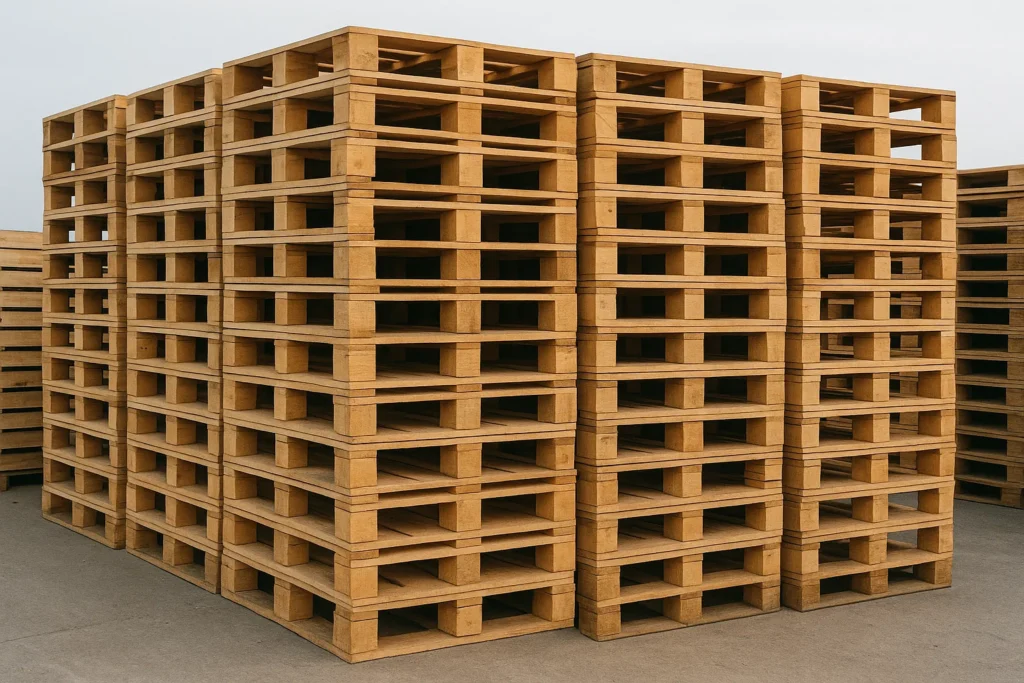
Cutting pallets isn’t the same as cutting regular boards. Pallets are tough, unpredictable, and often built to last. Here’s what makes them more challenging than they look:
1. Mixed Wood Types
Pallets are made from all kinds of wood—often whatever is cheap and available. You might get:
- Hardwood, like oak or maple, which is dense and slows down the saw.
- Softwood, like pine, which cuts easier but can still be rough.
You can’t always tell what wood you’re dealing with until you start cutting. That’s why you need a saw that can handle both.
2. Hidden Nails and Fasteners
Pallets are full of nails, staples, and sometimes even screws. Many are rusted or hidden under wood or paint.
Hitting a nail can dull or chip your blade instantly. Even if your saw can handle light nail contact, frequent hits will still wear it down fast.
3. Tight Construction
Pallets are made to be strong. Boards are packed close together and nailed tight.
This means you’ll need a saw that can work in narrow gaps without flexing too much or getting stuck.
4. Dirt, Grime, and Debris
Used pallets are rarely clean. Sawing through dirt, oil, or sawdust buildup adds resistance and wears the teeth faster.
Some blades have coatings that reduce friction or resist gumming up—but not all do.
What to Look for in a Pallet-Cutting Hand Saw
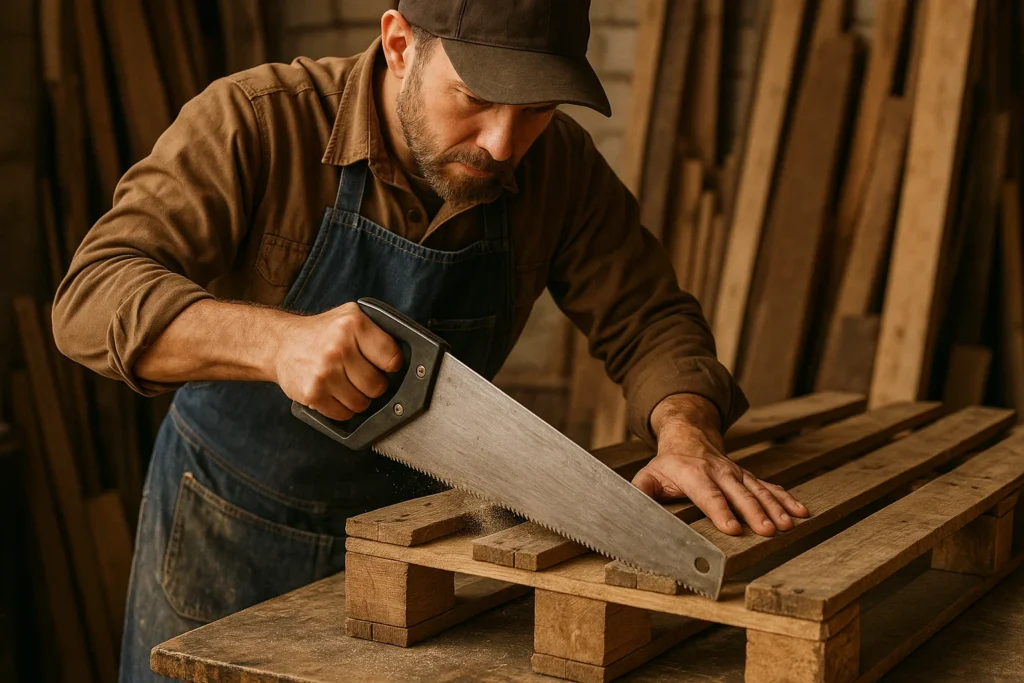
Not every hand saw can handle pallets. Some cut too slow. Others dull too fast or bend under pressure. Here’s exactly what to look for when picking the right one.
1. Tooth Design
Tooth shape and count affect how fast and smooth your cuts are.
- Look for aggressive teeth — usually 7 to 11 TPI (teeth per inch).
- Fewer teeth (like 7 or 8 TPI) cut faster and remove more wood with each stroke.
- More teeth (like 10–11 TPI) give a smoother finish but may cut slower.
- Avoid fine-tooth saws meant for finish work or trim. These will struggle with tough pallet wood and get stuck easily.
- Hardened or impulse-hardened teeth are a plus. These stay sharp longer and don’t need sharpening. Perfect if you’re cutting rough, nail-filled wood and don’t want to maintain the blade often.
2. Blade Length
The blade should be long enough to give smooth strokes, but not so long it becomes hard to control.
- Ideal range: 15″ to 22″
- Go shorter (15″–18″) if you’re working in tight spaces or need precise cuts.
- Go longer (20″+) for faster, straight cuts through full slats or thicker wood.
Don’t just assume longer is better. It depends on how much room you have to work and how big the pieces are.
3. Handle Comfort & Grip
Cutting pallets takes effort. A good handle keeps your hand from cramping.
Look for:
- Ergonomic shape that fits your grip.
- Non-slip materials like rubber or textured plastic.
- No sharp edges or awkward corners that dig into your hand.
If you’ll be cutting for more than a few minutes, comfort becomes just as important as blade quality.
4. Blade Strength & Flexibility
You want a blade that doesn’t bend easily.
- A thicker blade holds its shape better when cutting through knotty or twisted wood.
- Thin blades flex too much and can bind (get stuck) in tight slats.
Check that the blade feels solid, not flimsy.
5. Nail Tolerance or Replaceable Blades
Pallets have nails. Sooner or later, you’ll hit one.
- Some saws are designed to survive occasional nail contact without chipping.
- Others offer replaceable blades, which is great if you know you’ll be cutting through fasteners often.
This saves you from buying a whole new saw if the teeth get damaged.
Top Use Cases & Matching Saw Types
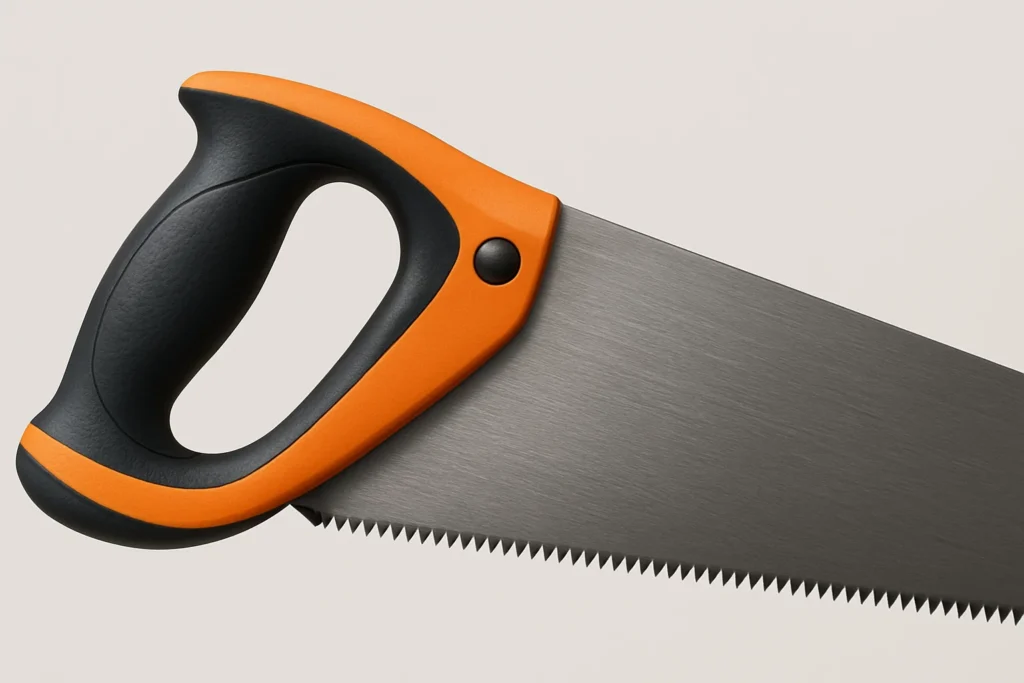
Not everyone cuts pallets the same way. Your cutting method depends on what you’re trying to do with the wood.
Here are the four most common pallet-cutting goals—and which type of hand saw fits best for each one.
1. Breaking Down Full Pallets
Goal: Cut across multiple boards quickly to remove slats or cut through end blocks.
Best Saw Type:
- Long-blade hand saw (20″–22″)
- Low TPI (7–9 TPI) for faster, aggressive cutting
Why it works: A long blade covers more distance with each stroke and powers through thick or stubborn wood faster.
Fewer teeth per inch mean you’re removing more material with each pass, which is what you want when speed matters.
2. Cutting Slats In Place
Goal: Slice individual slats while they’re still attached to the pallet frame (usually in tight gaps).
Best Saw Type:
- Shorter blade (15″–18″)
- Stiff, narrow blade to fit between boards
Why it works: You’re dealing with limited space. A shorter saw is easier to control and less likely to bend while working between tight boards.
3. Cutting Through Nails or Fasteners
Goal: Cut directly through slats that still have nails, without removing them first.
Best Saw Type:
- Nail-tolerant hand saw
- Saw with replaceable blade
Why it works: No matter how careful you are, you will hit nails. Choosing a saw built to handle it—or one that doesn’t cost much to replace—saves money and frustration in the long run.
4. Preparing Pallet Wood for Furniture or Projects
Goal: Make cleaner cuts with less splintering for projects like shelving, planters, or rustic tables.
Best Saw Type:
- Medium tooth saw (10–11 TPI)
- Blade with finer finish but still strong enough for pallet wood
Why it works: You don’t want rough, jagged edges. While these saws cut a bit slower, they leave behind cleaner cuts that need less sanding.
Safety Tips for Cutting Pallets by Hand
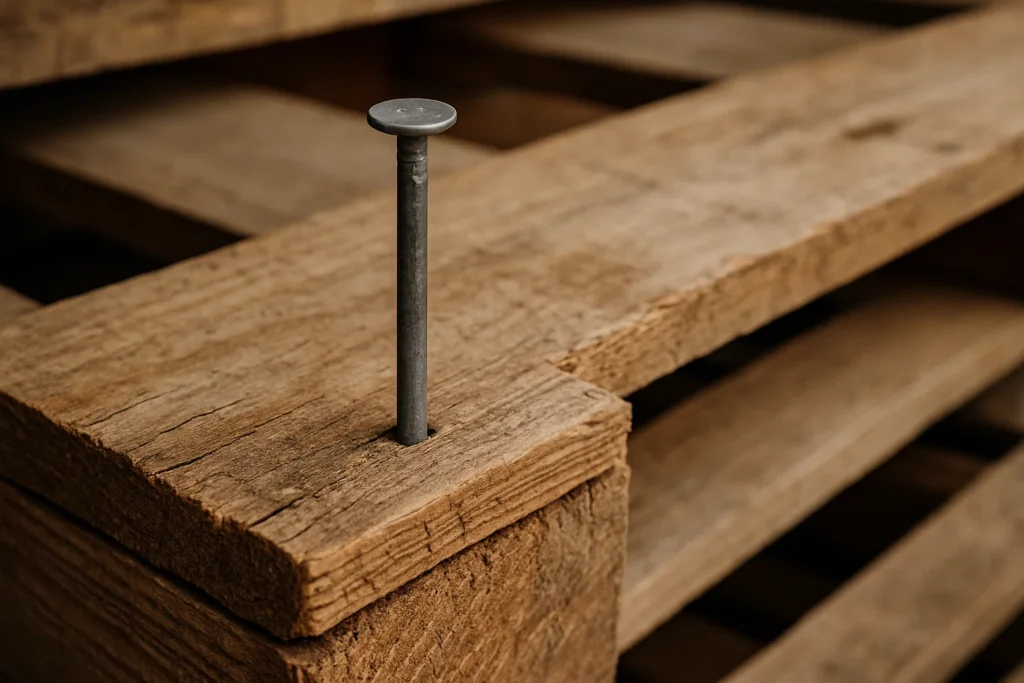
Cutting pallets might seem simple, but it’s easy to get hurt if you’re not careful. Pallets are full of rough wood, hidden nails, and awkward angles. Here’s how to stay safe while cutting:
1. Wear Gloves and Eye Protection
- Gloves protect your hands from splinters, sharp nails, and rough edges. Choose something thick but flexible so you can still grip the saw.
- Safety glasses are a must. When cutting old pallets, wood chips or nail fragments can fly off without warning.
Even if you’ve cut pallets before without gear, all it takes is one surprise nail to cause serious injury.
2. Check for Nails Before You Cut
- Use a magnet or just your eyes to check the cutting line for nails or screws.
- If you hit a nail at full speed, you could dull your blade or send a metal shard flying.
If you’re in a rush, at least scan both sides of the wood quickly. Nails can hide just below the surface.
3. Steady the Pallet
- Use clamps, a workbench, or even your foot (carefully) to keep the pallet from moving.
- A sliding pallet makes sawing harder and more dangerous.
You don’t want to be sawing while the wood wobbles or shifts—it leads to bad cuts and more risk of slipping.
4. Don’t Force the Saw
Let the saw do the work. If it’s sharp and the teeth are right for the job, it will cut naturally with steady strokes.
Forcing it increases your chance of losing control or slipping, especially when hitting knots or damp spots.
Final Thoughts
Cutting pallets takes more than just any old hand saw. Between hidden nails, mixed wood types, and tight board spacing, you need a saw that’s tough, sharp, and easy to control.
Whether you want speed, clean cuts, or portability, there’s a saw on this list that fits.
Pick the one that matches your job, and you’ll get through pallets faster, safer, and with better results.
Bahco’s 244P‑20‑U7‑HP Barracuda is a rugged 500 mm high‑speed‑steel handsaw with 7 tpi toothing and a comfy two‑component handle, delivering stable, razor‑sharp cuts and lasting edge retention for heavy‑duty pallet work.
If you see any kind of mistake in our content, make sure to reach out to us.
Frequently Asked Questions (FAQs)
What saw is best for cutting pallets?
The best saw for cutting pallets depends on your needs. For manual cutting, a handsaw with 7–9 TPI and a stiff, long blade works well for rough cuts.
If you prefer power tools, a reciprocating saw with a demolition blade handles nails and tough wood.
A circular saw offers clean, fast cuts but is less ideal if nails are hidden. Choose based on your workspace, budget, and whether you need portability or precision.
What is the best way to cut pallets?
The best way to cut pallets is to first check for nails or screws, then use the right saw based on your goal.
For breaking pallets down fast, cut the slats near the end blocks with a reciprocating saw or pry them off first.
If you’re keeping the wood clean for projects, use a circular saw or handsaw to cut through slats carefully. Clamp the pallet or steady it to avoid slips.
Can you cut pallets with a chainsaw?
Yes, you can cut pallets with a chainsaw, but it’s not ideal. Chainsaws are designed for logs, not nail-filled construction wood.
Hitting a nail can damage the chain and pose a safety risk. Use a chainsaw only if you’re cutting large sections at once and can confirm there are no nails in the path.
For better control and safety, use a reciprocating saw or handsaw instead.
What is a pallet blade?
A pallet blade is a saw blade designed to handle rough, nail-filled wood often found in pallets.
It’s typically used in reciprocating or circular saws and features reinforced teeth, often with a carbide coating, to resist damage from nails and hard materials.
These blades are built for durability and are useful in demolition or pallet reclamation work.
What are the three types of pallets?
The three main types of pallets are:
- Stringer pallets – Use two or three boards (stringers) for support. Common in North America.
- Block pallets – Use nine blocks for support, allowing four-way entry for forklifts. Strong and versatile.
- Double-face pallets – Have decks on both the top and bottom for added strength and load stability.
Each type is used based on shipping needs, material, and handling equipment.
The Grain Bros was started to serve woodworkers who can’t find products for their specific use case. We found out that there are not many media outlets extensively covering this topic. That’s why, we are here, to do the research and find the perfect products for your next DIY project. So you don’t have to juggle your tools and laptop at the same time.
If you see any kind of mistake in our content, make sure to reach out to us.

